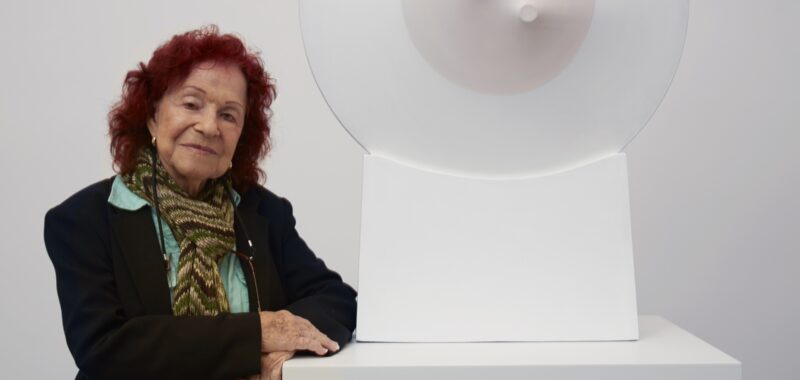Cuban artist Zilia Sánchez, whose dimensional paintings bridge geometric abstraction and eroticism, died at 98 on Wednesday, December 18. The news of her death was confirmed by Galerie Lelong in New York, her representing gallery since 2013.
Born in Havana, Cuba, in 1926, Sánchez was exposed to art at a young age: Her father was a hobbyist painter and artist Víctor Manuel was her neighbor and mentor. After receiving her education in the city’s Escuela Nacional de Bellas Artes San Alejandro, the nation’s oldest and most acclaimed institution, she began exhibiting in group and solo presentations. Early into her career, Sánchez worked in set and communications design, creating imaginative backdrops for guerrilla theater groups in the 1950s during the Cuban revolution. Her painting series Afrocubanos (1956–58) investigated African traditions and rituals instrumental to the development of Palo, the diasporic religion born following the Atlantic slave trade, through crisp lines, bold shapes, and gray and yellow palettes. Sánchez also worked as a graphic designer for the Spanish publication Zona Carga y Descarga (1972–75) and spent a year in Spain studying conservation at the Prado Museum.

Sánchez relocated to New York City in the early 1960s, in the wake of Fidel Castro’s rise to power in Cuba. There, her sensual, biomorphic style clashed with the Hard-edge and Minimalist currents of the mainstream art world. It was during this period that Sánchez began experimenting with stretching canvas over hand-crafted wooden constructions to create the volumetric surfaces for which she would become most celebrated. Evocative of taut skin and curvaceous corporeal forms, her “erotic topologies” evinced a sensibility to the sinuous rhythms of the natural world and their echoes in the female body.
“This is an egg, it’s the world, and it’s a breast. Three things,” Sánchez said in a 2013 interview.
Many of her paintings are titled after women warriors and heroines of Greek mythology, such as Antigone, whose story of resistance and defiance resonated with Sánchez’s own experiences of political exile and being a gay woman artist in male-dominated spaces. Her modular sculptural canvases in mostly white, gray, and muted colors, with their allusive geometries that leave ample room for interpretation, invite humor, fluidity, and pleasure.

In the 1970s, Sánchez relocated permanently to Puerto Rico, where she pursued this visual language on a massive scale by creating murals for a group of apartment building facades . Hurricane Maria tore through the archipelago in September 2017, ripping off the roof of her studio in the Santurce neighborhood of San Juan and destroying decades worth of work. A group of her former art students helped her reconstruct the space, and the artist persevered to create a new oeuvre that included freestanding sculptures exhibited at Galerie Lelong in 2019.
Though Sánchez has been the subject of major exhibitions in recent years and is regularly represented in marquee auctions of Latin American art, the artist’s works were relatively unknown in the United States throughout much of her career. One of her paintings was included in the São Paulo Biennial in Brazil in 1959, but it was not until decades later, in 2017, that her work was shown at the Venice Biennale. One of Sánchez’s signature moon-shaped pieces, “Lunar” (1980), was included in the Central Pavilion exhibition of this year’s Biennale, Foreigners Everywhere.

In 2019, the Phillips Collection in Washington, DC, mounted Zilia Sánchez: Soy Isla (I Am an Island), a solo exhibition of the artist’s work that traveled to El Museo del Barrio in New York and Museo de Arte de Ponce in Puerto Rico. The title was drawn from the artist’s poetic self-characterization, referencing both her literal upbringing in Cuba and Puerto Rico and her oscillating state of distance from and deep connection to her surroundings.
“I often say, ‘I am an island. Understand it and walk away.’ The earth and the rocks are solid, but they don’t float,” Sánchez said, quoted in a statement shared by Galerie Lelong. “I like to float and feel free.”
The Museo de Arte de Puerto Rico in San Juan will present Topologías / Topologies, a solo exhibition that originated at the Institute of Contemporary Art Miami, in spring 2025.
Sánchez is survived by her partner, Victoria Ruiz.

